By Johna Till Johnson
Photos by Vladimir Brezina
On a beautiful Sunday morning, Vlad went out to photograph chicks on the beach.
No… it’s not what you’re thinking!
We were staying at the Don CeSar Hotel in St. Pete Beach, Florida, where my company had just finished its annual conference. We tacked on a few days of vacation at the end.
And on the last day we heard about something unusual: a patch of beach where black skimmers (a kind of tern) were hatching their chicks. It was about a half-mile or so up the beach to the north, sandwiched right between hotels, roped off but otherwise out in the open, among the sunbathers and beach joggers.
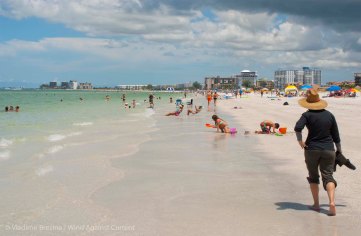 So not too early on a Sunday morning, Vlad and I ventured out to see the skimmers and their chicks.
So not too early on a Sunday morning, Vlad and I ventured out to see the skimmers and their chicks.
.
.
As we got close to the nesting area, we saw that a huge flock of the skimmers had made their way out of the roped-off area to the hard sand by the water’s edge. There, they stood in a cluster, chattering (their cry goes something like “ip-ip-ip”, or occasionally “eep-eep-eep”).
The black-and-white, orange-beaked adults appeared to be watching expectantly as the fuzzy gray hatchlings, and their older gray-and-white siblings, scampered back and forth.
I’m no biologist. I leave that to Vlad (but even he knows more about slugs and crabs than wild birds).
So I’m just guessing at this, but it appeared that the adults were attempting to teach the juveniles how to skim the water for food. Skimmers fly low over the water with open beaks, with the lower mandible—which, uniquely, is quite a bit longer than the upper one—submerged, catching fish and other tasty tidbits (hence the name).
At any rate, here’s what happened: Occasionally one of the younger birds would approach an adult and duck its head submissively. It looked for all the world like the younger bird was asking to be fed.
The adult ignored the request, instead looking towards the water impassively. Sometimes it would take a short demonstration flight over the waves, beak open, and then return. The younger bird would then hop towards the water, flap its wings, and open its beak. Even though it couldn’t fly yet, it seemed to be getting the idea: Water meant food, and skimming the waves was how to get the food.
We were fascinated.
I couldn’t believe such a phenomenon was happening right in front of us, with humans all around.
Strangely, most of the other humans on the beach seemed oblivious. One woman let her small boy chase the birds, alarming the adults, who took off in the air to circle protectively around the flightless juveniles, who scampered and “eeped”, trying to avoid being stepped on.
And several adult runners ran straight through the flock. I don’t think any of them even noticed that only some of the birds were able to fly off.
Fortunately, the birds seemed to survive the interruptions unharmed. Apparently they’ve reached a reasonable level of comfort interacting with humans—we don’t hurt them, and they ignore us, except when we get very close.
That’s a phenomenon we’ve noticed over and over again in the Tampa-St.Pete area: The wildlife seems to adapt remarkably to the presence of humans. (A native Floridian later pointed out that one reason may be the plethora of parkland in the area, which is an intentional feature. Various housing regulations dictate that houses be no more than a few blocks from parks, which means both that there is plenty of wildlife habitat, and that the wildlife is in close proximity to humans.)
At any rate, the skimmers seemed more-or-less unperturbed by the presence of dozens of bathing-suit-clad sun-worshippers, even when they accidentally disturbed the flock. And after we’d watched at the water’s edge for a while, we headed to the roped-off area where the nests and new hatchlings were.
There, the sand was peppered with adult skimmers, who appeared to be nest-sitting. Occasionally a small gray head would pop out of the sand, and a tiny voice would pipe “eep-eeep-eep”. One pair of chicks was nestled in a patch of seaweed at the base of one of the signs.
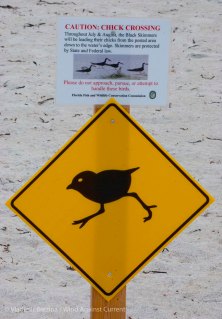 The signs posting the nesting site were neatly lettered, but appeared to be homemade. Our favorite was the yellow-and-black “Chicks crossing”.
The signs posting the nesting site were neatly lettered, but appeared to be homemade. Our favorite was the yellow-and-black “Chicks crossing”.
.
.
After an hour or so watching, I had to head back to the hotel for an appointment. But Vlad stayed on to take more photos of chicks (and their parents) on the beach.
Here are his photos from the day (click on any photo to start slideshow):

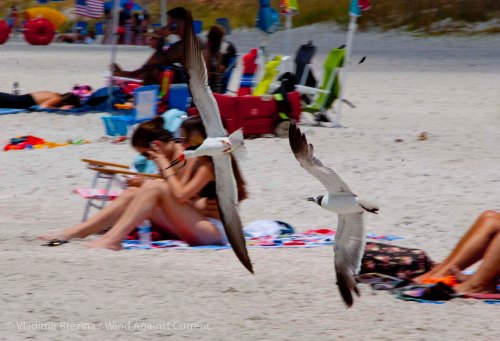
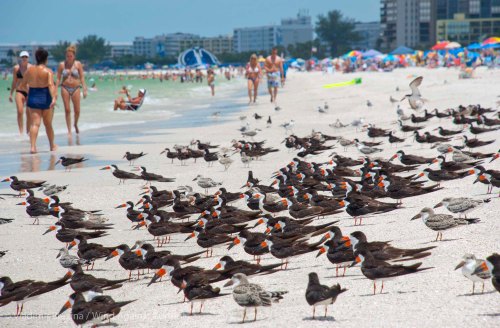
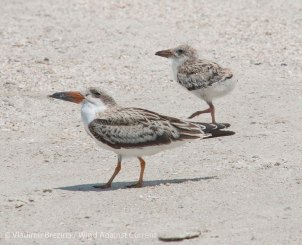
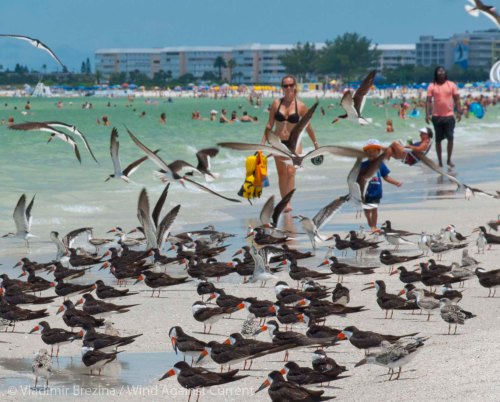
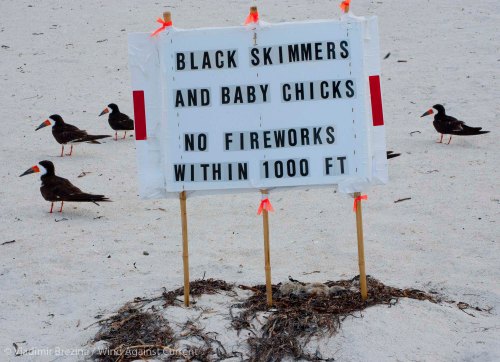
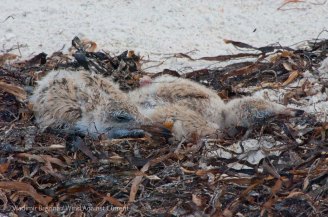

































Pingback: Everybody Loves the Beach | Wind Against Current
It looks like a biofarm ;-)
LikeLike
It does! But it’s almost the opposite. The birds have most likely been coming to this beach for centuries—before there were many humans to be concerned about. Now they are surrounded by them, but they still stubbornly defend their shrinking turf…
LikeLike
That is really cool! How neat that you could see it first hand (and take pictures to share it with us). The birds really have adapted to the humans, haven’t they. Which is good for them, but I’m always surprised at how oblivious people are to their surroundings.
Nancy
LikeLike
I am pretty sure the birds really don’t like the humans all around them, but they have no choice—they have no other habitat. And it may be a blessing that most of the humans are oblivious—it’s much better than if they were to harass the birds, as sometimes happens…
LikeLike
beautifil pics
LikeLike
Thank you!
LikeLike
Wow, that is just incredible! What fun to watch!
LikeLike
:-) Thanks!!
LikeLike
Fantastic photos, Vlad.I see that you did manage to get a few ‘chicks’ in with your chicks. :D Great post. I enjoyed.
LikeLike
He swears they were unintentional. :-)
LikeLiked by 1 person
They were everywhere—so hard to avoid! :-)
LikeLiked by 1 person
Great photo essay!
LikeLike
Thanks, Maya!
LikeLike
LOL Love the cheeky title.
LikeLike
It was even more cheeky, but we toned it down for our family audience…
LikeLiked by 1 person
Great photos and interesting story – hope you enjoyed your stay in St. Pete
LikeLike
We always do! Have been there a few times in recent years—looking back, quite a number of the posts on Wind Against Current are from there!
LikeLike
I like the title. Yes focus on the chicks. The bird chicks, that is! ;-)
LikeLike
The title does say exactly what the post is about ;-)
LikeLike
Of chicks and chicks!
LikeLike
:-)
LikeLike
The title didn’t mislead me. That is exactly what I expected! Ha! Very nice stuff! You guys season the seasons! Thanks!
LikeLike
We knew we couldn’t fool you! Thanks, George!!
LikeLike
very interesting! great story and pictures!
LikeLike
Thanks!!
LikeLike
Love the ‘rebel’ and wonder did he finally take his first swim on that particular day? As for the br.. child – one can only blame the parent for allowing his thoughtless behaviour.
LikeLike
Yes, his mother halfheartedly restrained him only after Johna looked like she might intervene. But then later, when his mother thought we weren’t looking, she let him do it again…
LikeLike
Great to get the full story after your teaser pic a couple of weeks ago. I love the yellow sign, and the birds’ amazing tenacity in hanging on to their territory against the odds. I guess they can’t do that without local human support, which is encouraging after all the bad environmental news that we hear.
LikeLike
The local people down there—the tourists, perhaps not as much, out of ignorance—are very supportive, it seems, mostly by deliberately ignoring the birds, which is probably the best thing they can do :-)
LikeLike
Good to know :-)
LikeLike
Fabulous! It’s Black Skimmer paradise, and no wonder you were entranced. They are amazing birds, and it’s gratifying to see everyone sharing the beach that well. Love the photo that shows two different sized chicks, too.
LikeLike
I’d never seen black skimmers before, so this was quite a sight! :-)
LikeLike
Absolutely amazing story! The birds consider the humans just another species hanging around. Stunning! I have never seen Black Skimmers, they look so beautiful with these candy corn beaks.
Chasing wild animals is natural for little children. Shame on their parents for their ignorance.
Thank you for sharing!
LikeLike
In the wild, species that don’t directly compete for food generally ignore each other, and this seems to be a good example ;-)
Yes, dogs and little children are the real danger…
LikeLike
You are right about the competition:)
Sad that grown up and somewhat educated people have no empathy for the living creatures.
Thank you again, have a great week!
LikeLike
Thank you—you too! :-)
LikeLiked by 1 person
Wonderful!
LikeLike
Thank you!!
LikeLike
Pingback: Boundaries | Wind Against Current